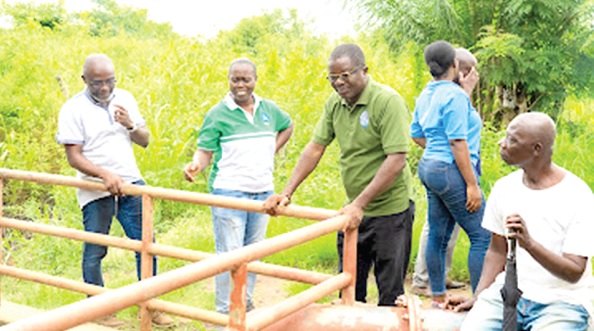The Weta and the Okyereko irrigation schemes in the Volta and Central regions respectively are arguably two vibrant schemes that can produce to feed the nation and help cut down on the importation of rice.
For the Okyereko scheme in particular, it can become an improved seed production hub for the country if the right measures and investments are made.
In 2018, feasibility studies were conducted between the Ministry of Food and Agriculture and the Korea International Cooperation Agency (KOICA) under a project dubbed, “Rice value chain improvement in the Central Region.”
Following that, the Okyereko scheme was chosen as a rice seed production unit.
The project was started in 2019 and is expected to be completed in 2024.
It involves the training of farmers to produce quality rice seeds on a pilot basis.
To make it more sustainable, a seed processing unit has been established for the scheme.
Potential, employment
The two schemes have a total potential irrigable land area of about 1,081 hectares (ha) out of which Weta alone constitutes 950 ha.
Beneficiary farmers on the schemes are 1,226, with Weta having 1,095 farmers and Okyereko 131 farmers. In all there are 191 irrigation schemes in the country.
Irrigable area for expansion at the Okyereko scheme is 24 ha while the Weta scheme has an estimated 400 ha of additional lands for commercial farmers and another 200 ha of lowland area affected by floods to be reclaimed under the West Africa Food System Resilience Programme(FSRP), a World Bank funded initiative.
Under the FSRP, the Weta scheme is to be rehabilitated and modernised to help increase rice and vegetable yields.
The project is expected to start within the next three months after the necessary documentations are completed.
The acting Chief Executive Officer (CEO) of GIDA, Richard Oppong-Boateng, told the Daily Graphic during three days of separate tours of the two schemes that output, which averaged 4,400 tonnes of rice for two cropping seasons on 550ha, would be increased to 950 ha with an output of 11,400 tonnes of rice for two cropping seasons per year after expansion of the Weta scheme.
He added that the average income of some 1,095 farmers, made up of 840 men and 255 women under Weta scheme, would be enhanced while the indirect jobs it offered to 5,000 people in its 23 catchment communities could also double upon completion of the project.
The acting GIDA CEO equally revealed that Okyereko could cultivate 16,000 tonnes of rice instead of the current 8,000 tonnes it was producing in one whole year.
He said the scheme had the capacity to also produce thousands of rice seeds but it had so far produced 30 tonnes of rice seeds on a pilot basis.
The Central Regional Manager of GIDA and Okyereko Scheme Manager, Ebenezer Kwami, said farmers were being trained under the KOICA initiative to produce seeds even after the programme ends.
There is also a rice seed processing unit with dryers and the requisite machines and with the farmers producing at least eight tonnes per hectare, it is possible for the scheme to become the rice seed producing hub for the region and the country as a whole.
Challenges
But for the two schemes to reach their full potentials, much needs to be done to address some of the challenges facing the schemes and their beneficiary farmers.
The challenges the farmers complained of included damaged retaining walls, also known as the protective weir that prevents flooding of the rice fields by holding water and regulating its flow at the Okyereko Irrigation Scheme.
Others are lack of credit facilities and inadequate equipment like power tillers, transplanters, levellers and tractors to cart harvested rice from the fields to the drying floors.
Some of the farmers equally complained of the general high cost of agricultural inputs and identified encroachment and flooding of portions of their cultivated land area as some of the issues that needed urgent attention.
Other challenges facing the farmers include land development and preparation which are two different expensive activities of irrigation schemes.
Land development refers to the alteration of landscape or changing landforms from a natural or semi-natural state for a purpose such as agriculture.
On the other hand, land preparation typically involves ploughing, harrowing and levelling the field to make it suitable for crop growth.
It is worth mentioning that development of irrigable land for agricultural purposes to avoid dependence on rain-fed agriculture to promote all year round farming leaves much to be desired.
This is because available figures show that 12 per cent or 228,000 ha of the 1.9 million ha of irrigable land has been exploited for irrigation for agricultural productivity.
In all, 1.672 million ha, representing 88 per cent of the country's irrigable land, remains to be developed.
However, Mr Oppong-Boateng argued that a farmer needs GH¢ 50,000 to develop one hectare of land so if the government and the private sector could support farmers by tackling the land development issue they could produce more with good agronomic practices.
Mr Kwami, when contacted, described some of the challenges like flooding of the rice fields as “unforseen circumstances,” stressing that in spite of the issues no farmer should be deterred from producing to full capacity.
He acknowledged that although some of the challenges could be daunting, with good agronomic practices they should be able to produce at full capacity.
The Okyereko scheme manager mentioned Esi Obondzi as one of the beneficiaries of the scheme who was adjudged the 2022 Central Regional Best Rice farmer.
Mr Kwami further argued that the 62-year old woman produced eight tonnes of rice per hectare, which was arguably rare in the country because most of the farmers produced on the average between 5.5 and six tonnes of rice per hectare.

